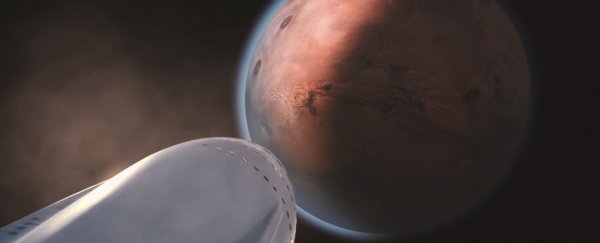Mars is the future. It's after all NASA's current overarching goal to send humans to the Red Planet. But even as early as the 1950s, aerospace engineer Wernher von Braun, had published his vision of a mission to Mars in his book The Mars Project.
We've also heard visions of settling the Red Planet under the leadership of a private organisation before. So why does Elon Musk get so much attention? And how feasible are his ideas?
Musk has too much business acumen, cash, and technological know-how to be dismissed as a dreamer. He built a rocket company, SpaceX, from scratch – now contracted by NASA to deliver cargo to the International Space Station (ISS).
It is also going to transport astronauts into space from next year. Musk has a proven track record of making things happen, so perhaps we can learn from his plans to overcome the two major obstacles that face anyone planning to send humans to Mars: funding and the health of the crew.
Under the current scenarios, a journey to Mars takes about six months.
The crew would, therefore, be exposed to the effects of long-duration spaceflight where muscle and bone loss occurs under the prolonged exposure to microgravity. These effects appear to be largely reversible, though.
Of more concern is the radiation exposure when the crew leaves Earth's protective magnetic field. There is currently no shielding technology that would keep the increased cancer risk for the crew below legally accepted limits.
And this does not take into account the need to protect astronauts from solar flares, too, in the short term. Musk offers no real solution here other than using the spaceship at the best angle for protection.
With the help of in-orbit refuelling, Musk does plan to reduce the transit time from six months to 80 days initially and maybe 30 days eventually, which would significantly decrease these risks.
Otherwise, he admits that the first missions, in particular, will pose real risks and anyone signing up basically has to be "prepared to die".
However, more than 200,000 people signed up for the astronaut selection for Mars One – a rival mission to create a permanent human settlement on Mars in the 2020s – which offered only a one-way ticket to Mars.
So the threat is unlikely to be a show-stopper, considering also that Musk's plans do include a return option.
Impossible timeline?
Musk estimates that, with the traditional approach like NASA's Apollo programme, the cost of sending humans to Mars will be about US$10 billion per person.
He plans to reduce these costs by several orders of magnitude to US$200,000 per person – the average price of a home in the US and comparable to the amount charged for a suborbital flight with Virgin Galactic. His aim, he says, is to make it affordable for anyone who wants to go.
To lower the costs, Musk is designing a fully reusable system that will be refuelled in orbit with a new kind of propellant that can also be produced on Mars. We've seen these ideas before, and Musk has credibility here by successfully demonstrating controlled landings of rocket boosters for reuse.
Refuelling in orbit provides increased propulsive power, which shortens the transit time to Mars and allows larger spaceships to be sent to Mars that can carry more people and cargo.
Mars One plans also include an orbit refuelling option, whereas NASA is designing a new rocket, the Space Launch System, that is supposed to eventually provide enough power to send astronauts to Mars in a single shot.
NASA's approach avoids the upfront costs of the additional hardware and infrastructure for refuelling but it limits its options to the small number of about six astronauts and a long transit time.
And here is the point where Musk's plans become truly ambitious and out of touch with his projected timeline of sending the first ship to Mars as early as 2022 (he admits he is bad at timelines). His transit ships are supposed to take 100 people in one go.
SpaceX has yet to successfully take its first astronauts into space, starting with a modest number of two to fly in its Dragon capsule. To upscale this to an interplanetary cruiser transporting 100 people and keeping them alive on their journey to Mars seems a tall order, even for Musk.
An audience member at Musk's presentation asked about the small matter of sanitation, for example. The explosion of his Falcon 9 rocket on the launch pad at the beginning of September shows that it is not called rocket science for nothing.
Notwithstanding the significant technological challenges to achieve the grand scale of Musk's plans, the maths of lowering the costs only works if the ships will be reused often and if all seats on board are sold.
The prospective Mars settlers would not only have to accept the risks but also find a way to pay the US$200,000 price tag.
Even with this buy in, there are enormous upfront costs to develop and build the necessary infrastructure and put it into place around Earth and on Mars.
Musk admits that raising the cash is his biggest challenge and that it will have to be some kind of public-private venture in the end.
Success of his plans ultimately will come down to whether he can find enough like-minded people who will put all of their own assets on the line for the greater goal of making humanity an interplanetary species, as well as to secure government buy-in and private investors who will demand some kind of a profit.
Christian Schroeder, Lecturer in Environmental Science and Planetary Exploration, University of Stirling.
This article was originally published by The Conversation. Read the original.
![]()
